The Many Faces of Diwali
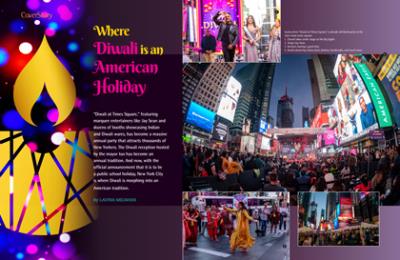
From cherished memories of past Diwali celebrations in India to a report on New York’s massive block party—held every year in Times Square for the past decade—our bumper issue’s five cover story articles reveal Diwali’s many faces, including how one interreligious couple celebrates it.
By Lavina Melwani, Monita Soni, Lakshmi Palecanda, Amritha Alladi Joseph, and Bhavana Kunnath.

Where Diwali is an American Holiday
“Diwali at Times Square,” featuring marquee entertainers like Jay Sean and dozens of booths showcasing Indian and Diwali wares, has become a massive annual party that attracts thousands of New Yorkers. The Diwali reception hosted by the mayor too has become an annual tradition. And now, with the official announcement that it is to be a public school holiday, New York City is where Diwali is morphing into an American tradition.
By LAVINA MELWANI
Scenes from “Diwali at Times Square,” a decade-old block party at the city’s most iconic square
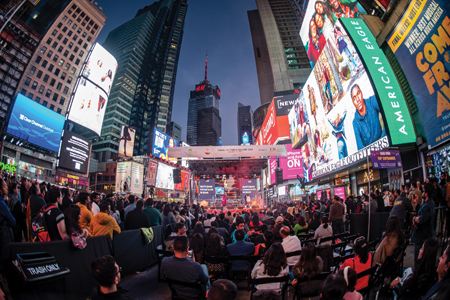
Diwali takes center stage at the Big Apple.
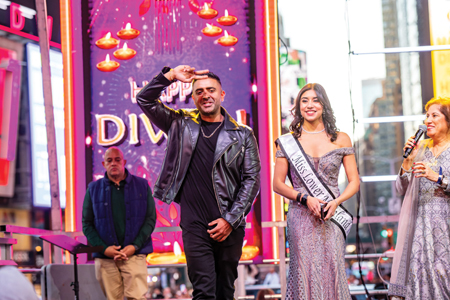
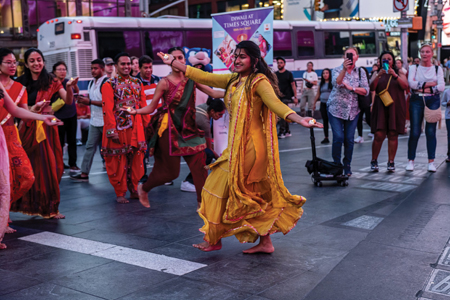
[Top Left ] Singer Jay Sean. [Top Right] Revelers having a good time.
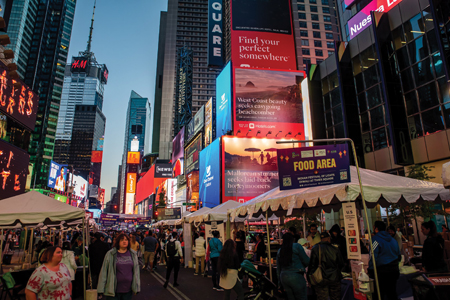
What can be a stronger endorsement for Americanization of Diwali than a public school holiday for the festival? That is now the case in New York City which has the nation’s largest school system. This has become possible due to the spirited efforts of Eric Adams, NYC mayor; and Jenifer Rajkumar, New York state representative.
[Left] Booths featuring Indian food, fashion, handicrafts, and much more.
There was a triumphant air at this year’s annual Diwali reception hosted by the mayor. A large Ganesh statue welcomed over 1100 guests. Dressed in their Diwali best, they looked as diverse as India itself—speaking many languages and belonging to many faiths, representing all parts of the sub-continent as well as the Caribbean islands which also celebrate Diwali as a major festival.
The mayor’s party was truly a desi party with endless samosas, mithais, and more. Out of respect for the festival, the menu was all vegetarian. Food from Perrine, the restaurant of the Pierre Hotel, was one of the attractions. Chef Abhinav Sharma did not disappoint, offering creative options such as the waffle dosas. Like any true-blue Diwali bash, it was a raucous party with dhol players and a DJ playing Bollywood music. There was henna painting for the women, mango and malai kulfis, and a hand-painted diya to take home. Five noted Hindus were honored with citations. The Gracie Mansion, the official residence of the mayor of New York City, had gone all desi for Diwali.

New York Senator Joe Addabbo, flanked by NYC Mayor Eric Adams and others, as he makes the historic announcement of making Diwali a public school holiday.
Sure, the celebration of Diwali in public places such as malls or city landmarks has been happening in the U.S., yet the festival has mostly only interested the Indian community. It has, however, slowly been ascending in Americana through developments such as a Diwali stamp issued a few years back by the U.S. postal department. Increasingly, many school districts have also allowed students to take off for festivals such as Diwali, which are not otherwise a school holiday. But the declaration of a school- wide holiday for Diwali in New York City is a big milestone, one which will have an impact on coming generations as it marks the beginning of making Diwali an American holiday.
When talking about the Americanization of Diwali, few things compare to “Diwali in Times Square,” a massive block party organized by Neeta Bhasin, an entrepreneur in multicultural media. Going on for a decade now, it has become an anticipated city event full of concerts of major diaspora singers like Jay Sean, Bollywood singers and stars, high-energy performances by local groups, and dozens of booths featuring food, fashion, handicrafts, and much more.
The celebration is listed on all tourism calendars for the city. Over 400,000 pedestrians pass through Times Square every day and for many of them, it is their introduction to Diwali, a word they could hardly pronounce a few years back. The sparkling neon lights of Times Square highlight the Diwali symbol of the diya. Says Neeta Bhasin, “Only two major festivities are celebrated at Times Square—the ball drop on New Year’s Eve and Diwali!”
This year, The Pierre, a prestigious hotel facing Central Park, has also created a grand Diwali celebration for the South Asian community. Chef Abhinav Sharma says that many people don’t know the hotel’s Indian connection, but this longtime NY landmark had an Indian restaurant back in the ’50s. Now that it is owned by Taj Hotels, it even offers idli-dosas and aloo-gobhi parathas at breakfast and an Indian menu along with Italian and French fare at its restaurant, Perrine. For the big Diwali party, they have a tantalizing mix of East and West with traditional food as well as canapes like avocado and chickpeas pani puris, mutton sukka tacos, and khandvi and pomegranate chaat. Not to mention a Khau Galli Station with a pav bhaji cart, a Kathi Zone cart, and a Puchka cart!
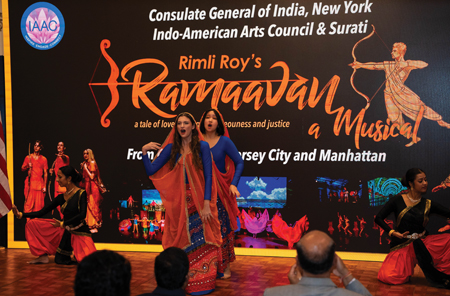
“Ramaavan,” an off-Broadway show introducing Ramayana, one of the origin stories of Diwali.
Rimli Roy, the founder of Surati Arts, has been working with her dance school for several years to finetune her musical “Ramaavan.” It is an appealing introduction to Ramayana, one of the Diwali origin stories. This off-Broadway show features Indian dance and music along with jazz, ballet, and western music; and a cast that is not representative of color or religion as it brings together people of all communities. Roy, in the spirit of New York, keeps adding multi-ethnic collaborations to it.
Acknowledging their Indian and American roots, second-generation Indian Americans are also creating cinema and arts that embrace both India and America. Film director Shilpa Mankiker has created “Diwal’oween,” a comedy about two festivals using a multi-ethnic cast, shot from Little India to Chinatown, and embracing the concept of being American. The film’s crew is 75 percent women and has won 13 awards at international film festivals. Mankiker is now in the process of marketing it to the burgeoning Indian population. She was at the mayor’s reception, dressed as Lady Liberty in a saree, getting the word out about her unusual film, a union of Diwali and Halloween.
Anu Sehgal’s organization, The Culture Tree, introduces Diwali and other Indian festivals to the third generation of South Asians who have never lived in the subcontinent. She has collaborated with museums such as the Children’s Museum of Manhattan, the Metropolitan Museum of Art, and Asia Society. So intense is the interest in Diwali this year that she is participating in 14 public Diwali parties for the third generation. One of her major events is partnered with the Seaport Museum, and includes dance performances, a dance workshop, and traditional art activities. There will also be a live DJ and a Diwali photo booth by Kulture Khazana and Desi Parents and Allies. The dance portion of the celebration will begin with traditional dances, the garba and dandiya raas. Once the sun sets, it will be time to float diyas in pools set up for the festival.
Megha Desai, of the nonprofit Desai Foundation, started “Diwali on the Hudson,” a fun event for younger people and it has grown over the years to embrace bigger and bigger venues and enthusiastic crowds. All proceeds from this event go toward helping girls and women in India so it encapsulates the true meaning of Diwali. Diwali has become so meaningful this year that even the NYC Tourism Department is highlighting it with “Diwali on the Hudson” plastered on digital kiosks all over the city.
As Desai says, "In New York, so many of us don't live near our parents and families. Everyone's really yearning for that cultural connection and for creating that opportunity to celebrate a kind of collective South Asian culture. And so, our first event ended up being a smash success and this year is going to be our 10th anniversary!"
Indeed, New Yorkers are all set to launch a real firecracker of an American Diwali!
Lavina Melwani is a New York-based journalist who writes for several international publications and publishes Lassi with Lavina (www.lassiwithlavina.com). Follow her on Instagram.

Remembering Diwali in Jaipur
The glamour of the bazaars and the pomp of the Ramleela pandals rubbed off on us in bringing the spirit of hope, joy, and celebration into our homes.
By MONITA SONI
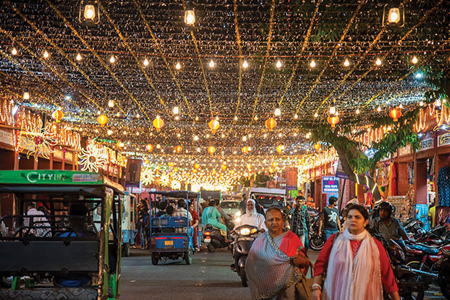
The dazzling Nehru Bazaar during Diwali. (Photo beautifuljaipur.com)
I have been fortunate to have spent parts of my childhood in many cities in north India. Over the years, I have received the gift of cherished memories of Diwali celebrations in diverse settings—atop toy trains in Darjeeling, in front of the Golden Temple in Amritsar, and at my grandparents' house surrounded by guava orchards in Chandigarh. But the one that stands out the most is the one in Jaipur, Rajasthan’s royal Pink City. In the late ’60s, we lived there in a lovely villa on the outskirts of the city, close to a public garden adorned with beautiful cenotaphs carved in pink sandstone.
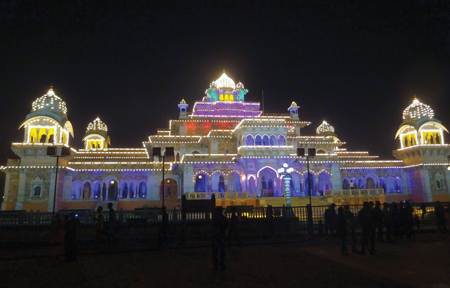
Albert Hall Museum, a city landmark, sporting festive lighting. (Photo Rafatalam100, Wikicommons)
Jaipur turned into a glittering jewel box.
When we first moved to Jaipur, I couldn't contain my excitement when Diwali was around the corner. My mother had often regaled me with stories of how the entire inner city transformed into a glittering jewel box during the festivities. The bazaars, such as Bapu Bazaar, Nehru Bazaar, and Johari Bazaar, would sparkle with 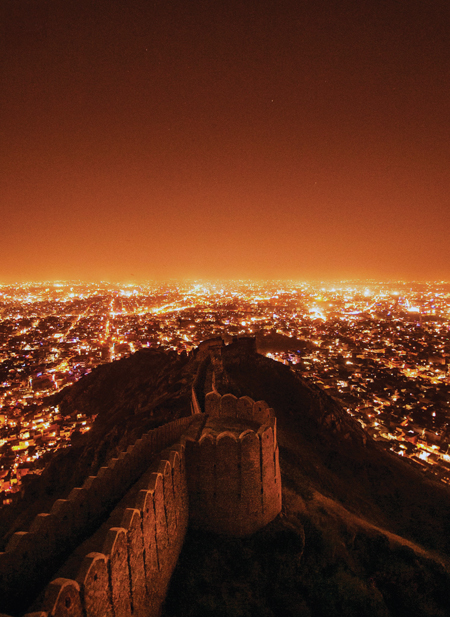 fronds, strings of lights, and lanterns. I couldn't wait to drive through historic landmarks like Sanganeri Gate, Ajmeri Gate, and Chand Pol to witness the beautifully decorated shops that displayed clothes, jewelry, firecrackers, sweets, and fruit. The ancient Purvmukhi Hanuman Temple at Sanganeri Gate, when lit up, was even more special. The wide Mirza Ismail Road became a party promenade with a sea of people walking around, dressed in their Diwali best, while shopping and tasting street food late at night.
fronds, strings of lights, and lanterns. I couldn't wait to drive through historic landmarks like Sanganeri Gate, Ajmeri Gate, and Chand Pol to witness the beautifully decorated shops that displayed clothes, jewelry, firecrackers, sweets, and fruit. The ancient Purvmukhi Hanuman Temple at Sanganeri Gate, when lit up, was even more special. The wide Mirza Ismail Road became a party promenade with a sea of people walking around, dressed in their Diwali best, while shopping and tasting street food late at night.
My dad’s favorite thing to do was to drive up the hills, passing the decorated Jalmahal Palace—that derives its name from standing in the middle of the lake—up to the Nahargarh Fort. He said that on Diwali, the view of Jaipur from Nahargarh Fort was mesmerizing. It is the best vantage point to see the walled city lit up like a bride bedecked in flashing gold jewels.
[Left] A view of the dazzling city of Jaipur during Diwali, from atop the Nahargarh Fort. (Photo Tarun & Arun, beautiful-jaipur.com)
The days leading to Diwali marked Navratri, a time when communities set up large pandals and performed Ramleela, the epic story of Lord Rama's 14-year banishment from his kingdom, the abduction of Sita by the demon king Ravana, and the fierce battle to rescue Sita. The eventual destruction of Lanka, the city of gold, by Hanuman after demons set fire to his tale. And the glorious return of Lord Rama, Sita, and Lakshmana to Ayodhya on Diwali.
A home infused with wonderful Diwali vibes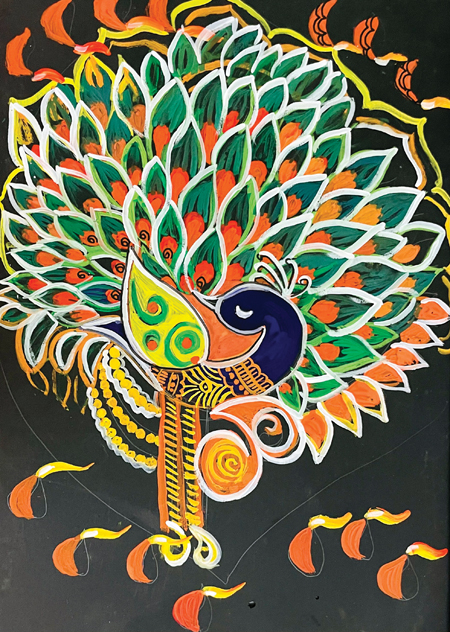
Our household buzzed with excitement as we prepared for Diwali. With schools and offices closed for the Diwali vacation, everyone had ample time for preparations. My parents would be in high spirits after having carefully budgeted to ensure that our festivities would be grand yet financially responsible. Mother was efficient in managing our preparations while father always tended to go a bit overboard, often spending more than his Diwali bonus.
The to-do list was endless: decluttering the house, sweeping it clean, giving it a fresh coat of paint both inside and outside, ordering new clothes, and preparing guest rooms for visiting family. We bought various items for the Diwali puja from seasonal stalls.
Sweets were a highlight of our Diwali celebrations. The only mithai my mother bought from the store was ghevar from the famous Lakshmi Mishthan Bhandar in Johari Bazaar. This traditional round, filigreed delicacy in a plate-like shape came freshly made in pure desi ghee and packaged carefully in pink cardboard boxes that fascinated me so much. My mother carefully unwrapped them and poured cardamom, pistachio, and rose-infused chasni (sugar syrup) over them just before serving, so that they retained their crunch and did not become soggy. Mom made other sweets like kalakand, peda, jalebi, balushahi, laddoo, sohan halva, and kala jamun at home.
[Right] A rangoli created by the author during a recent Diwali.
Thoughtfully crafted gift boxes filled with these delightful treats were prepared to be shared with friends and neighbors. We also arranged trays of dried fruits, featuring rows of almonds, walnuts, figs, apricots, and raisins. The doorway was adorned with mango leaf friezes while the Lakshmi puja room was decorated with sugarcane stems, copra (dried coconut), terracotta diyas (lamps), and khilone (toys) as fragrant flowers, colorful paper festoons, and elaborate rangolis added to the festive atmosphere.
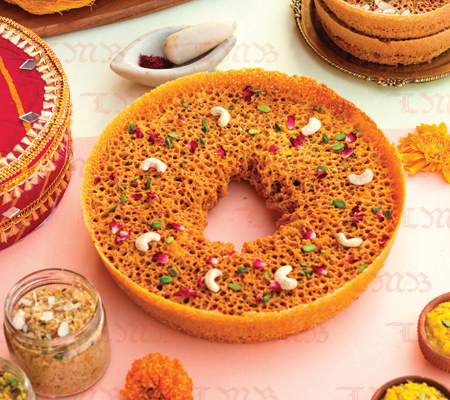
On Dhanteras, the day before Diwali, new silver or gold coins and jewelry were purchased, adding an extra oomph to our celebrations. My father, steeped in the essence of Diwali, had countless childhood memories of grand Diwali celebrations in Lahore, Shimla, Ambala, Amritsar, Ludhiana, and Calcutta. He didn't just provide for the festivities—he actively contributed to creating lasting memories for our family.
[Left] Ghevar from the famous Lakshmi Mishthan Bhandar in Johari Bazaar.
I used to sit beside my father every Diwali as he joyfully washed the heirloom Lakshmi and Ganesh coins, arranging them in his grandmother’s silver tray. Then he would sit in asana and inscribe "Om" and "Happy Diwali" in red ink on white paper. He would meticulously list the names of all our near and dear ones. He’d smile as he inscribed every new addition to the family tree. Over the years, I have come to treasure some of his handwritten lists of family members' names—just as I have treasured the joy of sharing Diwali with my family.
With one foot in Huntsville, Alabama, and the other in her birth home India, and a heart steeped in humanity, writing is a contemplative practice for Monita Soni. Her many poems, movie reviews, book critiques, essays, and two books, My Light Reflections and Flow through My Heart, have been published.

Remembering Deepavali in Coimbatore
Bathing with oil, cajoling the tailor to deliver your Diwali garments in time, and turning kitchens into manufacturing plants for yummy sweets and savories.
By LAKSHMI PALECANDA
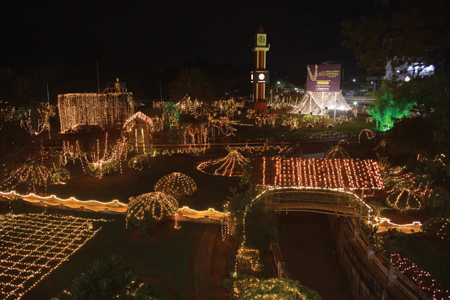
Coimbatore North flyover sporting Deepavali lights. (Photo: WeLuvCoimbatore)
Change is the only constant. I was reminded of this cliché recently when I visited Coimbatore, my hometown in Tamil Nadu. The “Cotton City” of my childhood has been transformed into one of the most vibrant, modern, and energetic cities in all of India. While I have been bringing up my own family in Mysore, Coimbatore has grown so much that I need a guide to navigate the once-familiar streets. Visiting Kovai, as it is also called, during the Deepavali season brought on such a wave of nostalgia that I was transported to the festival of my past.
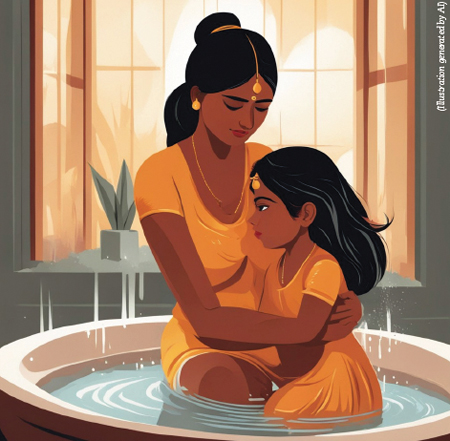
Deepavali, as we know it in South India (known as Diwali in North India), used to be a one-and-a-halfday celebration when I was young. As we were Kannadigas living in Tamil Nadu, we combined rituals from both states—Karnataka and Tamil Nadu. The night before Deepavali was called Neer Thumba Habba in our family. It was a ritual in which all the vessels that we used to store water were washed and decorated. Seeing how water scarcity was, is, and will probably always be a way of life in Coimbatore, this attention to the water vessels made sense. There used to be kheer or payasam for that evening.
[Right] “As a child, I dreaded the oil bath tradition,” says the author.
As a child, I dreaded the oil bath tradition. We were woken up at 4 a.m. and drenched in warmed-up gingelly oil. Then we’d have to work the oil out of our hair with a green powder made from the leaves of medicinal plants called arappu and shikakkai. With long hair practically up to my knees, it took forever. I still marvel at my mother’s patience and energy in tackling this tedious task for both her daughters.
 Once done with the hair ordeal, it was time for new clothes which, in those days, were purchased only for special occasions, not just because of “I feel like it” reason! Shopping for Deepavali was a festival in itself. The clothing stores would go all out to attract customers. The main shopping areas in Coimbatore in those days were Town Hall (Ukkadam), Cross Cut Road, and R.S. Puram. One year, two large clothing stores, Prakasham and Shobha, conducted a lucky draw with a gold coin as the first prize. People went absolutely nuts, pouring in from all over the state to buy at these shops.
Once done with the hair ordeal, it was time for new clothes which, in those days, were purchased only for special occasions, not just because of “I feel like it” reason! Shopping for Deepavali was a festival in itself. The clothing stores would go all out to attract customers. The main shopping areas in Coimbatore in those days were Town Hall (Ukkadam), Cross Cut Road, and R.S. Puram. One year, two large clothing stores, Prakasham and Shobha, conducted a lucky draw with a gold coin as the first prize. People went absolutely nuts, pouring in from all over the state to buy at these shops.
Tailors became VIPs overnight during the Deepavali season. One had to beg, plead, threaten, and cajole them to deliver the stitched garments in time for the season. (Illustration from Freepik)
The big deal about getting new clothes for the festival was dealing with the tailor who became a VIP overnight. The traditional girls wear was a full skirt and blouse or a half sari, both of which had to be tailored. The material was purchased by the length and given to the tailor, following which there were regular visits to beg, plead, threaten, and cajole him into finishing it in time for that year’s festival, not the next.
On the morning of the festival, the new clothes were placed in front of the altar with haldi-kumkum applied to the corners. To don those clothes for the occasion was a real thrill.
Next came fireworks. Like it or not, you had to have fireworks. It was the tradition. My father brought home many boxes of fireworks and my mother put them out in the sun on the days leading up to Deepavali because “they might not light up well if they had any dampness in them.” We divided them into three piles—one for the night before, one for the morning of, and a few for that evening. The largest pile was for the morning of Deepavali. Everybody had a front yard that could be used for bursting firecrackers, even if it was the road. You had to take your life in your hands if you wanted to go walking on Deepavali 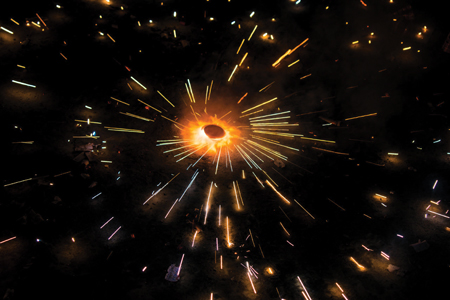 mornings. My father always bought sparklers, ground chakras, flower pots, and a noisy cracker called Red Fort. It was so much fun to see bright sparks fly from flower pots and the ground chakras. However, I used to be in awe of explosive fireworks like Lakshmi vedis, kuruvi vedis, and “atom bombs” that made a big boom. I even had a couple of classmates who nonchalantly lighted a firework in their hand and threw it just before it exploded.
mornings. My father always bought sparklers, ground chakras, flower pots, and a noisy cracker called Red Fort. It was so much fun to see bright sparks fly from flower pots and the ground chakras. However, I used to be in awe of explosive fireworks like Lakshmi vedis, kuruvi vedis, and “atom bombs” that made a big boom. I even had a couple of classmates who nonchalantly lighted a firework in their hand and threw it just before it exploded.
[Right] There used to be a time when firecrackers were front and center for kids during deepavali.
The firecracker session would be over by seven in the morning; and after a breakfast of idli-sambhar or uppuma, we’d be off to visit family and friends and exchange sweets. This was the time to get blessings from grandparents, uncles, and aunts, and check out our cousins’ and friends’ clothes.
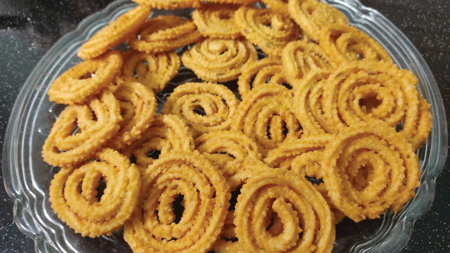 [Left] Chakkuli, the savory snack that is one of the staples in Deepavali.
[Left] Chakkuli, the savory snack that is one of the staples in Deepavali.
My two favorite festivals in the Hindu calendar were Krishna Janmashtami and Deepavali because both meant a lot of deep-fried crunchy snacks and loads of sweets. But the problem with Janmashtami was that everything was prepared on the same day and could be eaten only after the puja at night. However, there were no such limitations on the Deepavali food festivities! Preparations started days before. Even now, the aroma of hot oil brings back memories of Deepavali.
Those days, every single sweet or chakkuli was homemade. For one, the ones sold in the shops were usually substandard. But the real reason was that it was the time for the housewives to shine a light on their cooking prowess. The kitchens would go into high gear, churning out sweets and savories by the dabba. The questions during those days of the festival were always, “What did you make?” followed by “How did it turn out?”
The savories of choice were chakkuli, then kuzhal, muthsarai, ribbon pakoda, and mixture, while the sweets that reigned were coconut burfi, maida burfi, rava laddu, boondi laddu, halwa, and Mysore pak. There were always disasters galore. On occasion, the Mysore pak would cool to the consistency of granite, earning the name Mysore Rock, and the housewife would have to smile in chagrin all the while swearing to a) never attempt that blasted Mysore pak again and, b) get even with the other women who were mocking her. Another frequent Deepavali disaster was halwa which bonded eternally with the pan.
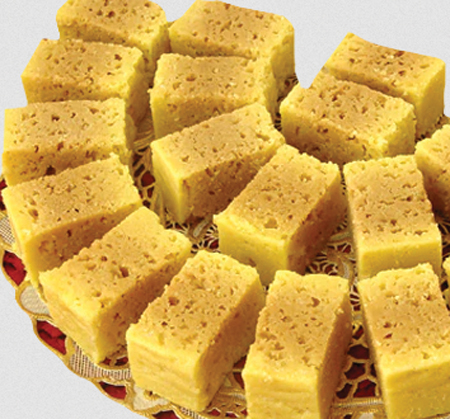
However, there was another side to this eat-fest. You ate what you got and you didn’t throw a fit. If you didn’t like rava laddu, tough luck. If you wanted padushah instead (I did), more tough luck. Nobody lost a moment’s sleep worrying that poor little me didn’t get my favorite sweet. As for the Mysore Rocks, they still had to be eaten, even if with the help of a hammer and chisel.
[Right] Mysore Pak, one of the many sweets of the season.
This time when I went to Coimbatore for Deepavali, I went to a reigning favorite, the famous Aanandha’s Restaurant. The array of sweets and savories was mind-boggling, and I could choose any permutation and combination I craved. It was hard but I persevered, and the very efficient staff packed it for me. As I came away with my purchases, I wondered if, had there been such an arrangement in the old days, my mother would have opted for it.
The shopping scene has also changed. There are many, many more glamorous shopping areas where the choice is astounding and they have a price range to suit every pocket. Unsurprisingly, people still flock to Coimbatore for their festival needs from neighboring states too, especially for local specialties like Coimbatore cotton!
As for the fireworks, people have become more conscious of the environmental problems caused by them, and often choose the green versions. Many people have also taken to lighting lamps to celebrate the festival, like our northern brethren.
After all, change is the only constant, no?
Humorist Lakshmi Palecanda moved from Montana to Mysore and is still adjusting. Besides being a regular contributor at The Deccan Herald, she is a published novelist.

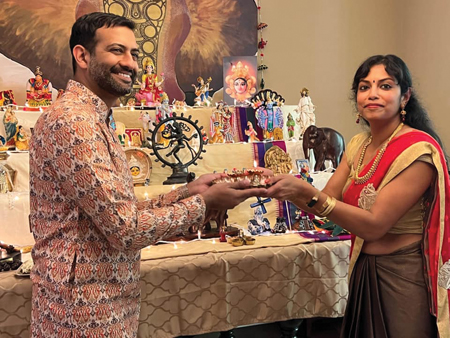 Most of what my husband remembers of his first Diwali celebration is a whirlwind of light, sound, and color. But one thing stands out clearly: it awakened him to other traditions of India beyond the Malabar coast. He had his first taste of paneer tikka masala, launching a lifelong love affair with the dish. He watched his peers make human pyramids and do somersaults in the air as he witnessed his first bhangra performance at a Diwali show. He set off fireworks with friends, who had adorned their doorsteps with intricate rangolis, and indulged in a rainbow of sweets oozing ghee and shimmering with foils.
Most of what my husband remembers of his first Diwali celebration is a whirlwind of light, sound, and color. But one thing stands out clearly: it awakened him to other traditions of India beyond the Malabar coast. He had his first taste of paneer tikka masala, launching a lifelong love affair with the dish. He watched his peers make human pyramids and do somersaults in the air as he witnessed his first bhangra performance at a Diwali show. He set off fireworks with friends, who had adorned their doorsteps with intricate rangolis, and indulged in a rainbow of sweets oozing ghee and shimmering with foils.
Jis Joseph would never have guessed, as a college freshman, that these “firsts” would one day become “forevers” after he got married. A lifetime of Diwali festivities awaited him. Along with his TamBrahm wife every year, he began to light sparklers, don new clothes, and help his young kids complete their Ganga snanam.
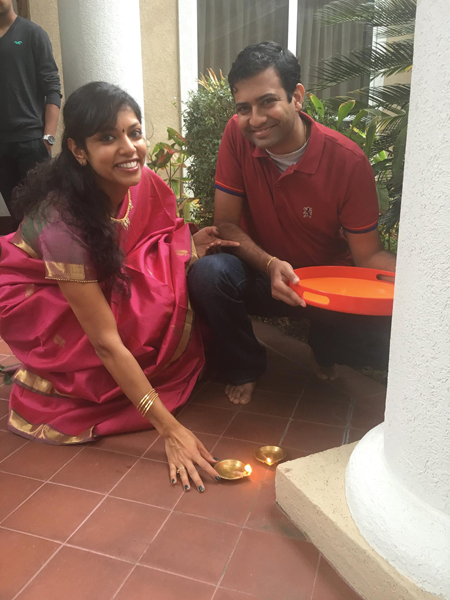
Jis’s college foray into desi culture exposed him to the kaleidoscope of Indian traditions representing a variety of faiths, languages, and even ways that Diwali—or Deepavali, as we called it—is celebrated. I admit that even I, a Hindu, learned something new each year based on how different communities marked the occasion.
During my primary school days in the ’90s, Deepavali celebrations in our home were marked by completing our ritual oil bath first thing in the morning and dressing ourselves in new garb purchased specifically for the occasion. This ritual is representative of immersing oneself in the holy Ganges, washing us over with prosperity and blessings for the year ahead. I would recite my morning stotra and eat prasad of paal poli, a deep-fried semolina poori soaked in sweet saffron milk. Before heading to school, we would call our relatives in India, shouting over an echoing phone line, “Ganga snanam aacha?” (“Have you completed your ritual oil bath?”)
In the weeks leading up to the holiday, my sister and I, having been raised in a classically trained family, would have practiced a Bharatanatyam dance to perform at the annual community Diwali show. While I loved learning the traditional art form that originated in the temples and courts of Tanjore, I envied my peers who replicated Madhuri Dixit’s latest moves, shaking their hips to “Mere Piya Ghar Aaya.” What a treat it was in my teen years when my parents finally allowed me to perform both Bharatanatyam and Bollywood dances to allay my fear of missing out. Eventually, I blended the two at the University of Florida by introducing the Gator Natyam, a modern take on traditional repertoire set to contemporary music. It appealed to the same audience whistling to those bhangra somersaults at Diwali events on campus. It was also how I ended up meeting Jis, who designed the T-shirts for our team.
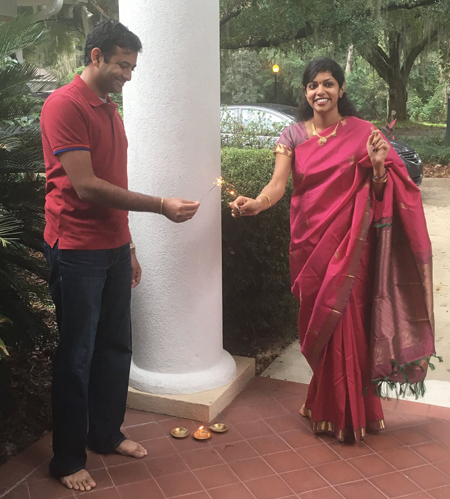 “Happy Deepavali,” I would wish my North Indian peers when the day finally arrived. “Oh, Diwali... it’s tomorrow,” they would say, referencing the day in honor of Lakshmi, goddess of wealth. Assuming that my friends had it right, I would tell my parents there had been a mix-up. They reminded me that our Tamil household celebrated Deepavali on the day marking Lord Krishna's victory over the demon Narakasura, while others celebrated Dhanvantari’s delivery of ambrosia to the gods, or the return of Lord Ram to his kingdom of Ayodhya.
“Happy Deepavali,” I would wish my North Indian peers when the day finally arrived. “Oh, Diwali... it’s tomorrow,” they would say, referencing the day in honor of Lakshmi, goddess of wealth. Assuming that my friends had it right, I would tell my parents there had been a mix-up. They reminded me that our Tamil household celebrated Deepavali on the day marking Lord Krishna's victory over the demon Narakasura, while others celebrated Dhanvantari’s delivery of ambrosia to the gods, or the return of Lord Ram to his kingdom of Ayodhya.
And, yes, these are many other interpretations! Therein lies the beauty of this holiday: regardless of when, how, or why you celebrate, it continues to enlighten you with a manifestation of light over darkness, good over evil, knowledge over ignorance. Universally, these are virtues that we—regardless of age, gender, race, ethnicity, nationality, religion, political affinity, physical abilities, or sexual orientation—can relate to and cherish. That’s why Diwali is so accessible and why Jis has been able to embrace its traditions so seamlessly.
Together, we promote these universal messages to our kids. We explain to our daughter the significance of the holiday using stories that resemble a Disney fairytale. My son is giddy with excitement as we light clay lamps and candles around the house. We wear new clothes (Jis often saves the shirts he received for Christmas the previous year).
We attend fetes that bring together our Hindu, Muslim, Christian, Jewish, and atheist friends alike. Someone supplies the fireworks that they have hoarded since the Fourth of July, setting the sky ablaze. We each catch a flame from another’s sparkler, praying that this chain of light will spread awareness and understanding, dispelling ignorance and ill-will for generations to come.
Amritha Alladi Joseph, a former reporter for Gannett newspapers, The Hindu, The Gainesville Sun, Gainesville Magazine, and CNN-IBN, is now a consulting manager at EY and lives in Sandy Springs, Georgia, with her husband and two children.

A Lone Island of Light
Deepavali has meant adopting new families and cousins, creating new communities, and bravely celebrating the victory of light over darkness in our small little Indian enclaves in American neighborhoods.
By BHAVANA KUNNATH
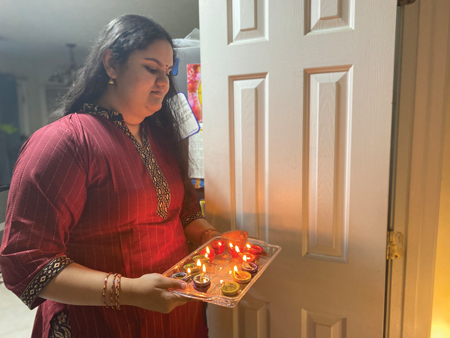 At the risk of annoying my mother, I will be honest: growing up, I did not care much for most Hindu holidays. As someone raised in America, I did not have the kind of reverence and anticipation for Indian festivals that my parents had. For them, these festivals were important opportunities to try to recreate the joy, traditions, and family fun surrounding the festivals that they had experienced in India as children. They did their best to keep these traditions alive in their American lives and to pass them down to me.
At the risk of annoying my mother, I will be honest: growing up, I did not care much for most Hindu holidays. As someone raised in America, I did not have the kind of reverence and anticipation for Indian festivals that my parents had. For them, these festivals were important opportunities to try to recreate the joy, traditions, and family fun surrounding the festivals that they had experienced in India as children. They did their best to keep these traditions alive in their American lives and to pass them down to me.
But growing up in Georgia, I had no days off from school to prepare and decorate for our holidays and no extended family of cousins, aunts, or uncles to share the excitement with. As a result, many of these celebrations quickly became a bit of a chore. The days of cleaning, the hours of decorating, and the trips to the temple competed with the mountains of homework I had. I also felt that, given a choice, I would've preferred to be left to my own devices.
But there was one festival that was an exception to the above. Deepavali never felt like a chore. For reasons I did not fully understand at the time, Deepavali felt exciting. Perhaps because it was the one celebration that did not require me to play the cultural translator. Explaining festivals like Vinayaka Chavithi to my friends at school was an exhausting affair. Even though my friends were respectful and supportive, I was always left with the sense that they really did not understand me and that my culture would always remain an intriguing oddity to them.
 Fortunately, Deepavali was one festival that American friends had at least some recognition of—thanks to the brief “Diwali is the festival of lights” lesson in school. What also helped was that when I talked about Deepavali, my school friends could actually relate to my experiences. After all, it could be boiled down to food, fireworks, family, and friends—practically a mix between the Fourth of July and Thanksgiving.
Fortunately, Deepavali was one festival that American friends had at least some recognition of—thanks to the brief “Diwali is the festival of lights” lesson in school. What also helped was that when I talked about Deepavali, my school friends could actually relate to my experiences. After all, it could be boiled down to food, fireworks, family, and friends—practically a mix between the Fourth of July and Thanksgiving.
But the real roots of my attraction to Deepavali lay deeper: it gave me things worth anticipating, reasons to care, and people to care about. Deepavali meant waking up to the scent of the pulihora and payasam that my mother made—and inevitably arguing with my brother over who was eating too much of it. It meant I was finally allowed to use the lighter to light the oil lamps. It meant pulling out the string lights that had been stuffed in boxes all year and taking charge of decorating the house. And it also meant pulling out the Crayola chalk and proudly covering the driveway with the muggulu I had been learning to draw on notebook paper.
[Left] The author’s mother doing a puja during Deepavali.
Deepavali also meant excitedly waiting for the call from the Morams, our family friends, asking us to join them in setting off the fireworks. It meant my best friend Keerti would tell me, yet again, the same story she always did about almost setting her shoe on fire while trying to set off a firecracker. Deepavali meant coming together with people I had come to care for.
Admittedly, though, celebrating Deepavali always made me feel vulnerable and self-conscious. Unlike Vinayaka Chavithi or Varalakshmi Vratams, Deepavali was not the kind of event we celebrated in the privacy of our home or in the separateness and sanctity of the temple. Deepavali happened out in the open—in the driveway of our homes and in front of an entire neighborhood (in which we were the rare Indians). Somehow the fact that we were always the only ones outdoors on those days made it feel like we were on stage for the whole neighborhood, an invisible audience watching us through their blinds. Maybe it was the silence, the darkness, the emptiness of that neighborhood on those evenings that gave me the sense that we were doing something risky. Maybe it was a lingering fear that someone—an annoyed neighbor or the H.O.A.—could rain on our parade with a few cold words or a mean stare.
But as my family friends and I exchanged mischievous glances and lit loud fireworks under the watchful gaze of our parents, the risky edge of our festivities dissolved, the itchy clothes stopped feeling so itchy and started to sparkle, the inconvenience of the homework waiting for us faded into the background, and the discomfort of being Indian (and the confusion of trying to figure out exactly what that meant) melted away into a heady mix of anticipation, affection, and carefree fun.
It was on those Deepavali evenings that I learned the meaning of terms like “Aunty” and “Uncle.” Like any good Indian child, I had been taught to refer to all elders as “Aunty” or “Uncle,” but it was when Sashidhar Uncle handed me the biggest firework and encouraged me to be bold and light it that I began to understand what it actually meant to have an uncle in name and bond if not in blood.
It was one thing to know I had cousins in India, to see them once every few years, to pretend we were not near-perfect strangers for our parents’ benefit, to stumble through awkward conversations on the phone where we tried to mimic the ease and perfect understanding of friendship with none of the foundations or shared experiences to fall back on.
It was another thing to stand there giggling with my newfound American “cousins” running away from lit crackers, turning our noses in sync at the rising plumes of smoke, whispering concerns about the homework waiting for us, complaining about our overly cautious parents, and sharing a spirit of conspiracy and reckless abandon with them. It was also another thing entirely to realize what it actually meant to have a cousin as we created memories together in the flickering light of the fireworks. Celebrating with them felt like melting into one family under the steady heat of the deepams.
 [Right] “A huddle of friends standing at the top of a driveway setting off firecrackers in a dark, quiet neighborhood and becoming family without noticing it.”
[Right] “A huddle of friends standing at the top of a driveway setting off firecrackers in a dark, quiet neighborhood and becoming family without noticing it.”
Even now, at twenty years old, when I think of Deepavali, I think of those bonds—not the stories about the holiday’s origins, not the inevitable flood of WhatsApp messages, not the quick “festival of lights” lesson we learned in school, not the much-anticipated food, but the image of us standing there giggling together at the top of that driveway that felt like a hill. Just a few kids in their best Indian clothes huddling together for warmth as our mothers and our new uncles and our new aunties laughed at our attempts to light sparklers and nudge one another towards the bigger fireworks. The memory that lasts is of us, the Deepavali merrymakers, being the only source of light and laughter illuminating the quiet, dark solemnity of our neighborhood on those cold fall nights. A lone island of light.
Even as we grew older and our families saw each other less often, as some of us moved so far apart that we could not come together for Deepavali as in the past, even as the years turned and it was just my parents, my brother, and I standing in the lawns outside of the Hindu temple watching the purple fireworks burst overhead, that sense of connection and illumination endured.
And what could be clearer and more enduring than that? The love of a family—of a family that was found, built, and borrowed all at once. Yes, the bonds made on those early Deepavali nights lasted, but there was something beyond that which persisted too. On the surface things have changed: our little community has expanded. Now, American friends or family members have started to dot the crowd. But something about that image of a crowd of strangers standing together to watch fireworks burst over the temple roof feels ancient, eternal even.
At the risk of making my mother smile, I will be honest: she was right. There never is enough time in our American calendar to celebrate these things, but we must celebrate them anyway. We have to choose to create time for Deepavali, to create time for family, to create families, to create community. The truth is that we are just strangers standing in our little family units tied together by nothing more than the vague thread of culture and the common commitment to make time, to create a community where there was none.
Maybe it is not the parades and nostalgia-inducing family gatherings my mother grew up with, but I wonder: is this not Deepavali too? A huddle of friends standing at the top of a driveway setting off firecrackers in a dark, quiet neighborhood and becoming family without noticing it. A crowd of strangers watching fireworks burst overhead and gradually collapsing into a community with every collective gasp. A lone island of light where everything feels a bit less lonely.
Bhavana Kunnath, a contributing writer for Khabar, is a student at Oglethorpe University. She can be reached at kunnathbhavana@gmail.com.

Enjoyed reading Khabar magazine? Subscribe to Khabar and get a full digital copy of this Indian-American community magazine.
blog comments powered by Disqus










